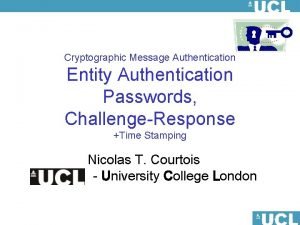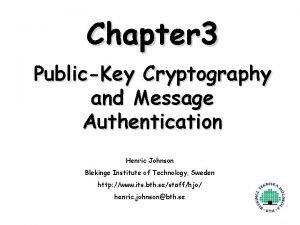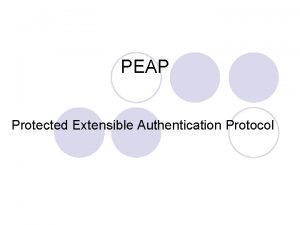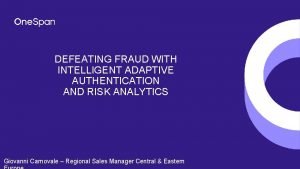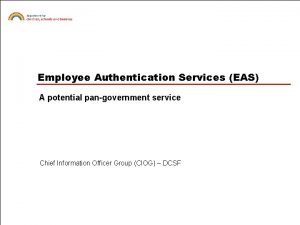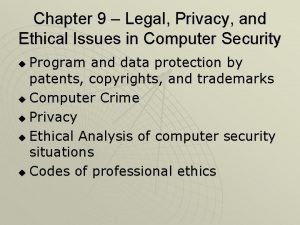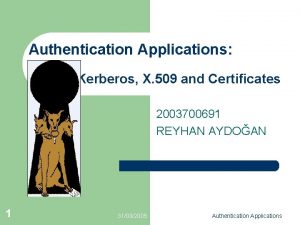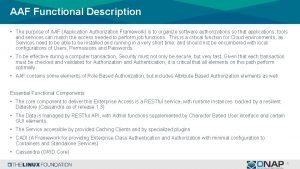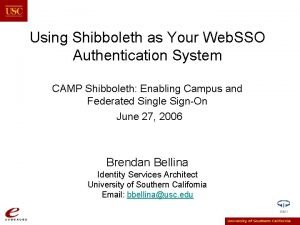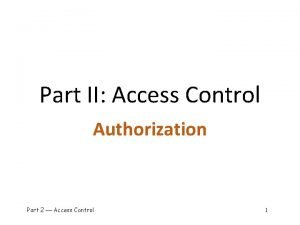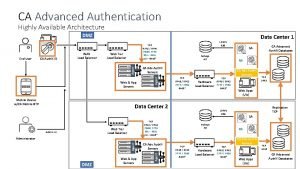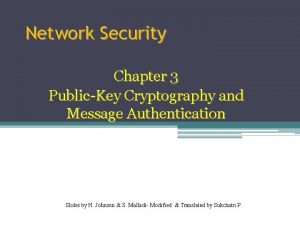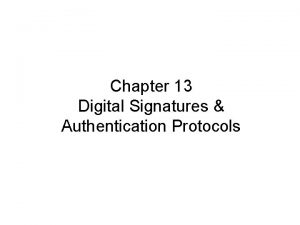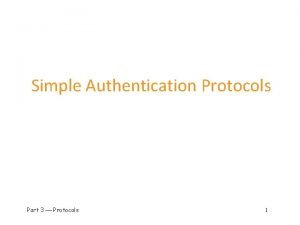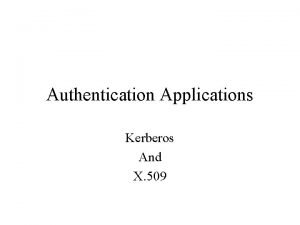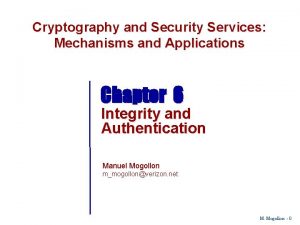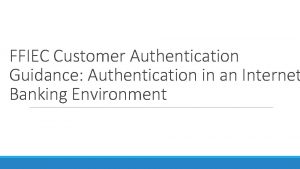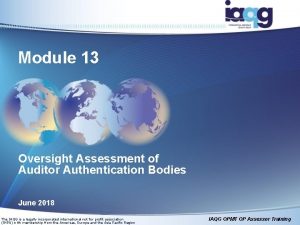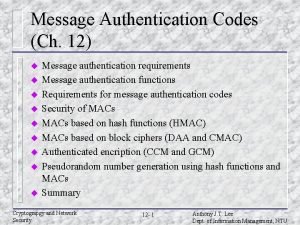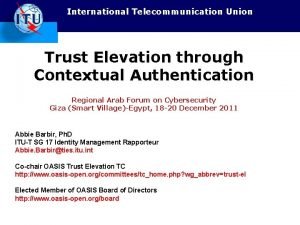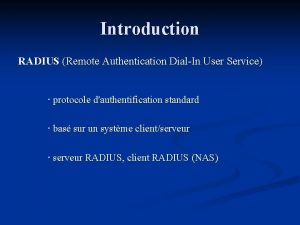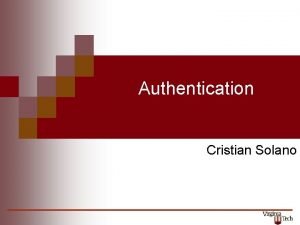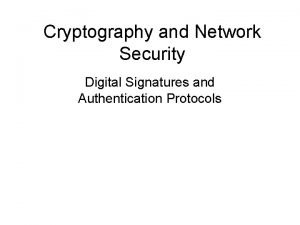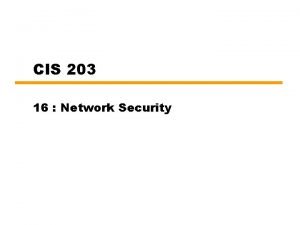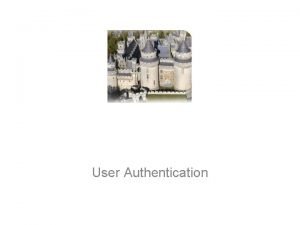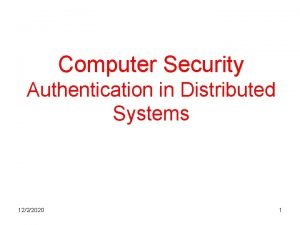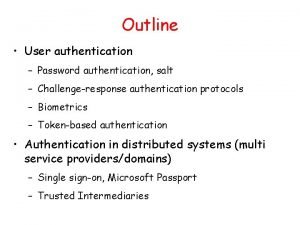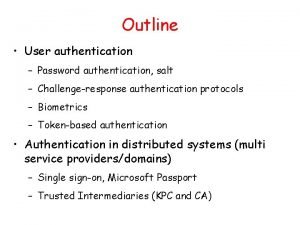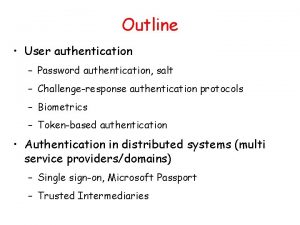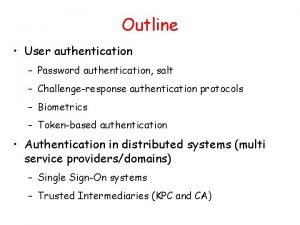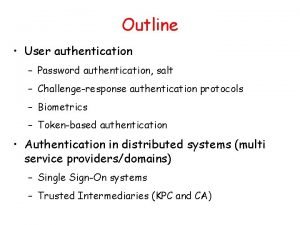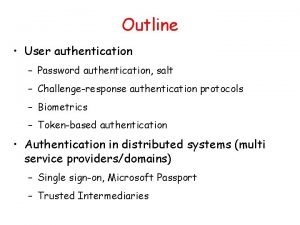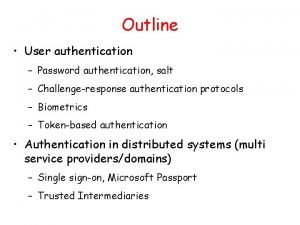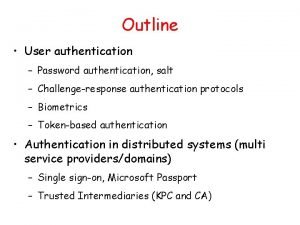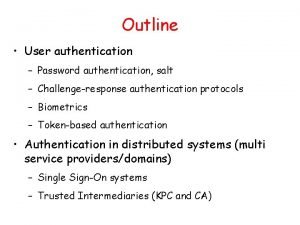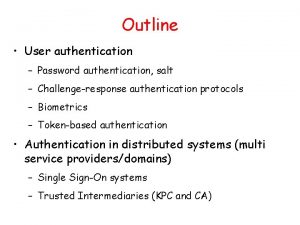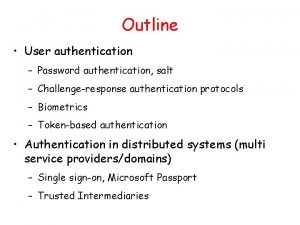Attacking Authentication Adam Fremd Overview O Authentication also






































































- Slides: 70

Attacking Authentication Adam Fremd

Overview O Authentication also lies at the heart of an application’s protection against malicious attack O Front line of defense O What could an attacker achieve if he were to target our authentication mechanism?

Authentication Technologies O HTML forms-based authentication. O Multi-factor mechanisms, such as those combining passwords and physical tokens. O Client SSL certificates and/or smartcards. O HTTP basic and digest authentication. O Windows-integrated authentication using NTLM or Kerberos. O Authentication services.

HTML O the most common authentication mechanism username and password O 90% of applications O Range from simple logins to multiple stage and multi-factor mechanisms using physical tokens

Design Flaws in Authentication Mechanisms O Authentication functionality is subject to more design weaknesses than any other security mechanism commonly employed in web applications O Bad Passwords O Very short or blank O Common dictionary words or names O Set to the same as the username O Still set to a default value

Bad Passwords HACK STEPS O Attempt to discover any rules regarding password quality: O Review the web site for any description of the rules. O If self-registration is possible, attempt to register several accounts with different kinds of weak passwords to discover what rules are in place. O If you control a single account and password change is possible, attempt to change your password to various weak values.

Bad Passwords

Brute-Forcible Login O If the application allows an attacker to make repeated login attempts with different passwords until the correct one is guessed, then it is highly vulnerable even to an amateur attacker who manually enters some common usernames and passwords into their browser.

Brute-Forcible Login O O O O testuser administrator demouser password 123 qwerty test 123 letmein [organization’s name]

Brute-Forcible Login O Given today’s bandwidth and processing capabilities, it is possible to make thousands of login attempts per minute from a standard PC and DSL connection.

Brute-Forcible Login

Brute-Forcible Login HACK STEPS O Submit several bad login attempts for an account you control, monitoring the error messages received. O After around 10 failed logins, if the application has not returned any message about account lockout, attempt to login correctly. If this succeeds, there is probably no account lockout policy. O If you do not control any accounts, attempt to enumerate a valid username and make several bad logins using this, monitoring for any error messages about account lockout. O To mount a brute-force attack, first identify a difference in the application’s behavior in response to successful and failed logins, which can be used to discriminate between these during the course of the automated attack.

Brute-Forcible Login O Obtain a list of common usernames and a list of common passwords. Use any information obtained about password quality rules to tailor the password list so as to avoid superfluous test cases. O Use a suitable tool or a custom script to quickly generate login requests using all permutations of these usernames and passwords. Monitor the server’s responses to identify login attempts that are successful O If you are targeting several usernames at once, it is usually preferable to perform this kind of brute-force attack in a breadth-first rather than a depth-first manner. This involves iterating through a list of passwords (starting with the most common) and attempting each password in turn on every username. This approach has two benefits: first, you will discover accounts with common passwords more quickly, and second, you are less likely to trigger any account lockout defenses, because there is a time delay between successive attempts using each individual account.

Verbose Failure Messages O If an application informs you as to which piece of information was invalid, you can exploit this behavior to considerably diminish the effectiveness of the login mechanism. Then use brute-forcible login attack

Verbose Failure Messages HACK STEPS O If you already know one valid username (for example, an account you control), submit one login using this username and an incorrect password, and another login using a completely random username. O Record every detail of the server’s responses to each login attempt, including the status code, any redirects, information displayed on screen, and any differences hidden away in the HTML page source. Use your intercepting proxy to maintain a full history of all traffic to and from the server. O Attempt to discover any obvious or subtle differences in the server’s responses to the two login attempts. O If this fails, repeat the exercise everywhere within the application where a username can be submitted (for example, self-registration, password change, and forgotten password).

Verbose Failure Messages O O If a difference is detected in the server’s responses to valid and invalid usernames, obtain a list of common usernames and use a custom script or automated tool to quickly submit each username and filter the responses that signify that the username is valid. Before commencing your enumeration exercise, verify whether the application performs any account lockout after a certain number of failed login attempts. For example, if the application will grant you only three failed login attempts with any given account, you run the risk of “wasting” one of these for every username that you discover through automated enumeration. Therefore, when performing your enumeration attack, do not submit a completely far-fetched password with each login attempt, but rather submit either (a) a single common password such as “password 1” or (b) the username itself as the password. If password quality rules are weak, it is highly likely that some of the attempted logins that you perform as part of your enumeration exercise will actually be successful and disclose both the username and password in one single hit. To implement option (b) and set the password field to the same as the username, you can use the “battering ram” attack mode in Burp Intruder to insert the same payload at multiple positions in your login request.

Vulnerable Transmission of Credentials O Potential eavesdroppers that look for unencrypted HTTP connections may reside: O On the user’s local network O Within the user’s IT department O Within the user’s ISP O On the Internet backbone O Within the ISP hosting the application O Within the IT department managing the application

Vulnerable Transmission of Credentials O Even on a secure HTTPS connection, unauthorized parties may exist: O Within the user’s browser history, within the web server logs, and within the logs of any reverse proxies employed within the hosting infrastructure. O When the login request being handled via a redirect to a different URL with the same credentials passed as query string parameters. O When Web applications store user credentials in cookies, usually to implement poorly designed mechanisms for login, password change, “remember me, ” and so on.

Vulnerable Transmission of Credentials HACK STEPS O Carry out a successful login while monitoring all traffic in both directions between the client and server. O Identify every case in which the credentials are transmitted in either direction. O If any instances are found in which credentials are submitted in a URL query string, or as a cookie, or are transmitted back from the server to the client, understand what is happening. Try to find every means by which an attacker might interfere with the application to compromise other users’ credentials. O If any sensitive information is transmitted over an unencrypted channel, this is, of course, vulnerable to interception. O If credentials are submitted using HTTPS but the login form is loaded using HTTP, then the application is vulnerable to a man-in-the-middle attack, which may be used to capture credentials.

Password Change Functionality O Applications should have password change functions to: O Mitigate threat of password compromise by reducing the window in which a given password can be targeted in a guessing attack and by reducing the window in which a compromised password can be used without detection by the attacker. O Be able to quickly change their password to reduce threat of unauthorized use.

Password Change Functionality O The password change functions my be vulnerable if it: O Provides a verbose error message indicating whether the requested username is valid. O Allows unrestricted guesses of the “existing password” field. O Only check whether the “new password” and “confirm new password” fields have the same value after validating the existing password, thereby allowing an attack to succeed in discovering the existing password noninvasively.

Password Change Functionality HACK STEPS O Identify any password change functionality within the application. If this is not explicitly linked from published content, it may still be implemented. O Make various requests to the password change function, using invalid usernames, invalid existing passwords, and mismatched “new password” and “confirm new password” values. O Try to identify any behavior that can be used for username enumeration or brute-force attacks

Forgotten Password Functionality O Design weaknesses in forgotten password functions frequently make this the weakest link at which to attack the application’s overall authentication logic. O Often involves secondary challenge such as questions about mothers’ maiden names, memorable dates, favorite colors, and the like will generally have a much smaller set of potential answers than the set of possible passwords. O This challenge is often much easier for an attacker to respond to than attempting to guess the user’s password

Forgotten Password Functionality

Forgotten Password Functionality O Users are inclined to set extremely insecure challenges, presumably on the false assumption that only they will ever be presented with them, for example: “Do I own a boat? ” O If an application allows unrestricted attempts to answer password recovery challenges, then it is highly likely to be compromised by a determined attacker.

Forgotten Password Functionality O In some applications, the recovery challenge is replaced with a simple password “hint” that is configurable by users during registration. Users commonly set extremely obvious hints, even one that is identical to the password itself, on the false assumption that only they will ever see them.

Forgotten Password Functionality O How to combat these vulnerabilities: O One reasonably secure means of implementing this is to send a unique, unguessable, timelimited recovery URL to the email address that the user provided during registration. Visiting this URL within a few minutes enables the user to set a new password. O But there are vulnerabilities to this method also, as attackers can be disclosed the password after successful login or disclosing the email used to the attacker.

Forgotten Password Functionality HACK STEPS O Identify any forgotten password functionality within the application. If this is not explicitly linked from published content, it may still be implemented. O Understand how the forgotten password function works by doing a complete walk-through. O If the mechanism uses a challenge, determine whether users are able to set or select their own challenge and response. If so, use a list of enumerated or common usernames to harvest a list of challenges, and review this for any that appear easily guessable. O If the mechanism uses a password “hint, ” do the same exercise to harvest a list of password hints, and target any that are easily guessable. O Try to identify any behavior in the forgotten password mechanism that can be exploited as the basis for username enumeration or brute-force attacks. O If the application generates an email containing a recovery URL in response to a forgotten password request, obtain a number of these URLs, and attempt to identify any patterns that may enable you to predict the URLs issued to other users. Employ the same techniques as are relevant to analyzing session tokens for predictability.

“Remember Me” Functionality O Applications often implement “remember me” functions as a convenience to users, to prevent them needing to reenter their username and password each time. O This function is often insecure by design and leaves the user exposed to attack both locally and by users on other computers.

“Remember Me” Functionality O “Remember Me” function generally uses a cookie. When this cookie is submitted to the initial application page, the application trusts the cookie to authenticate the user, and creates an application session for that person, bypassing the login.

“Remember Me” Functionality

“Remember Me” Functionality O Even if the information stored in a cookie for re-identifying users is suitably protected (e. g. , encrypted) to prevent other users from determining or guessing it, the information may still be vulnerable to capture through a bug such as crosssite scripting

“Remember Me” Functionality HACK STEPS O Activate any “remember me” functionality, and determine whether the functionality indeed does fully “remember” the user or whether it only remembers their username and still requires them to enter a password on subsequent visits. O Closely inspect all persistent cookies that are set. Look for any saved data that identifies the user explicitly or appears to contain some predictable identifier of the user. O Even where data stored appears to be heavily encoded or obfuscated, review this closely and compare the results of “remembering” several very similar usernames and/or passwords to identify any opportunities for reverse engineering the original data. O Attempt to modify the contents of the persistent cookie to try and convince the application that another user has saved his details on your computer.

User Impersonation Functionality O Some applications allow privileged users of the application to impersonate other users, in order to access data and carry out actions within their user context. O Some banking applications allow helpdesk operators to verbally authenticate a telephone user and then switch their application session into that user’s context in order to assist them. O This function has some design flaws though

User Impersonation Functionality O It may be implemented as a “hidden” function, which is not subject to proper access controls. For example, anyone who knows or guesses the URL /admin/Impersonate. User. jsp may be able to make use of the function and impersonate any other user. O The application may trust user-controllable data when determining whether the user is performing impersonation. For example, in addition to a valid session token, a user may also submit a cookie specifying which account their session is currently using. An attacker may be able to modify this value and gain access to other user accounts without authentication.

User Impersonation Functionality

User Impersonation Functionality O If an application allows administrative users to be impersonated, then any weakness in the impersonation logic may result in a vertical privilege escalation vulnerability an attacker may gain full control of the application.

User Impersonation Functionality O Back-door password is also vulnerable to discovery by an attacker if matched with the user’s actual password

User Impersonation Functionality HACK STEPS O Identify any impersonation functionality within the application. If this is not explicitly linked from published content, it may still be implemented. O Attempt to use the impersonation functionality directly to impersonate other users. O Attempt to manipulate any user-supplied data that is processed by the impersonation function in an attempt to impersonate other users. O If you succeed in making use of the functionality, attempt to impersonate any known or guessed administrative users, in order to elevate privileges. O When carrying out password guessing attacks, review whether any users appear to have more than one valid password, or whether a specific password has been matched against several usernames. Also, log in as many different users with the credentials captured in a brute-force attack, and review whether everything appears normal. Pay close attention to any “logged in as X” status message.

Incomplete Validation of Credentials O Some poorly designed authentication mechanisms not only do not enforce the good practices of a minimum length or the presence of both uppercase and lowercase characters in passwords, but also do not take account of users’ own attempts to comply with them.

Incomplete Validation of Credentials HACK STEPS O Using an account you control, attempt to log in with variations on your own password: removing the last character, changing the case of a character, and removing any special typographical characters. If any of these attempts is successful, continue experimenting to try and understand what validation is actually occurring. O Feed any results back into your automated password guessing attacks, to remove superfluous test cases and improve the chances of success.

Non-Unique Usernames O Flaws: O One user who shares a username with another user may also happen to select the same password as that user, either during registration or in a subsequent password change. O An attacker may exploit this behavior to carry out a successful brute-force attack, even though this may not be possible elsewhere due to restrictions on failed login attempts. O An attacker can register a specific username multiple times with different passwords, while monitoring for the differential response that indicates that an account with that username and password already existed.

Non-Unique Usernames HACK STEPS O If self-registration is possible, attempt to register the same username twice with different passwords. O If the application blocks the second registration attempt, you can exploit this behavior to enumerate existing usernames even if this is not possible on the main login page or elsewhere. Make multiple registration attempts with a list of common usernames to identify the already registered names that the application blocks. O If the registration of duplicate usernames succeeds, attempt to register the same username twice with the same password, and determine the application’s behavior: O If an error message results, you can exploit this behavior to carry out a bruteforce attack, even if this is not possible on the main login page. Target an enumerated or guessed username, and attempt to register this username multiple times with a list of common passwords. When the application rejects one specific password, you have probably found the existing password for the targeted account. O If no error message results, log in using the credentials you specified and see what happens. You may need to register several users, and modify different data held within each account, to understand whether this behavior can be used to gain unauthorized access to other users’ accounts.

Predictable Usernames O Attackers can quickly discern names and passwords if an application has usernames in a particular sequence such as cust 5331, cust 5332, etc. HACK STEPS O If usernames are generated by the application, try to obtain several usernames in quick succession and determine whether any sequence or pattern can be discerned. O If so, extrapolate backwards to obtain a list of possible valid usernames. This can be used as the basis for a brute-force attack against the login and other attacks where valid usernames are required, such as the exploitation of access control flaws.

Predictable Initial Passwords O In some applications, users are created all at once or in sizeable batches and are automatically assigned initial passwords, which are then distributed to them through some means. O Results in predictable passwords that attackers can break O More common on intranet-based corporate applications— for example, where every employee has an account created on their behalf, and receives a printed notification of their password.

Predictable Initial Passwords HACK STEPS O If passwords are generated by the application, try to obtain several passwords in quick succession and determine whether any sequence or pattern can be discerned. O If so, extrapolate the pattern to obtain a list of passwords for other application users. O If passwords demonstrate a pattern that can be correlated with usernames, you can try to log in using known or guessed usernames and the corresponding inferred passwords. O Otherwise, you can use the list of inferred passwords as the basis for a

Insecure Distribution of Credentials O If the message distributed contains both username and password, there is no time limit on their use, and there is no requirement for the user to change password on first login, then it is highly likely that a large number, even a majority, of application users will not modify their initial credentials and that the distribution messages will remain in existence for a lengthy period during which they may be accessed by an unauthorized party.

Insecure Distribution of Credentials HACK STEPS O Obtain a new account. If you are not required to set all credentials during registration, determine the means by which the application distributes credentials to new users. O If an account activation URL is used, try to register several new accounts in close succession and identify any sequence in the URLs you receive. If a pattern can be determined, try to predict the activation URLs sent to recent and forthcoming users, and attempt to use these URLs to take ownership of their accounts. O Try to reuse a single reactivation URL multiple times, and see if the application allows this. If not, try locking out the target account before reusing the URL, and see if it now works.

Implementation Flaws in Authentication More subtle and harder to detect

Fail-Open Login Mechanisms O Changing the log-in code to find any design flaws HACK STEPS O Perform a complete, valid login using an account you control. Record every piece of data submitted to the application, and every response received, using your intercepting proxy. O Repeat the login process numerous times, modifying pieces of the data submitted in unexpected ways. For example, for each request parameter or cookie sent by the client: O O O O Submit an empty string as the value. Remove the name/value pair altogether. Submit very long and very short values. Submit strings instead of numbers and vice versa. Submit the same item multiple times, with the same and different values. For each malformed request submitted, review closely the application’s response to identify any divergences from the base case. Feed these observations back into framing your test cases. When one modification causes a change in behavior, try to combine this with other changes to push the application’s logic to its limits.

Defects in Multistage Login Mechanisms O Elaborate login mechanisms involving multiple stages: O Entry of a username and password. O A challenge for specific digits from a PIN or a memorable word. O The submission of a value displayed on a changing physical token. O In several cases where a combination of flaws is present, multistage logins can even result in a solution that is less secure than a normal login based on username and password.

Defects in Multistage Login Mechanisms O Flaws: O Attackers may bypass stages in the login if the application is designed to assume that previous logins were correct. O Attackers may interfere with login transition red flags and modify application to allow procession with only partial credentials. O Attackers may use multiple identities and passwords on the same user identity at different stages of the login process.

Defects in Multistage Login Mechanisms HACK STEPS O Perform a complete, valid login using an account you control. Record every piece of data submitted to the application using your intercepting proxy. O Identify each distinct stage of the login and the data that is collected at each stage. Determine whether any single piece of information is collected more than once or is ever transmitted back to the client and resubmitted, via a hidden form field, cookie, or preset URL parameter. O Repeat the login process numerous times with various malformed requests: O O Try performing the login steps in a different sequence. Try proceeding directly to any given stage and continuing from there. Try skipping each stage and continuing with the next. Use your imagination to think of further ways of accessing the different stages that the developers may not have anticipated.

Defects in Multistage Login Mechanisms HACK STEPS If any data is submitted more than once, try submitting a different value at different stages, and see whether the login is still successful. It may be that some of the submissions are superfluous and are not actually processed by the application. It might be that the data is validated at one stage and then trusted subsequently — in this instance, try to provide the credentials of one user at one stage, and then switch at the next to actually authenticate as a different user. It might be that the same piece of data is validated at more than one stage, but against different checks — in this instance, try to provide (for example) the username and password of one user at the first stage, and the username and PIN number of a different user at the second stage. O Pay close attention to any data being transmitted via the client that was not directly entered by the user. This may be used by the application to store information about the state of the login progress, and may be trusted by the application. For example, if the request for stage three includes the parameter “stage 2 complete=true” then it may be possible to advance straight to stage three by setting this value. Try to modify the values being submitted and determine whether this enables you to advance or skip stages. O

Defects in Multistage Login Mechanisms O Attackers may be able to break the “secret” questions on logins by: O Discovery of question and answer within a hidden HTML form field or cookie O Cycling through questions until they arrive at one which they know the answer to

Defects in Multistage Login Mechanisms HACK STEPS O If one of the login stages uses a randomly varying question, verify whether the details of the question are being submitted together with the answer. If so, change the question, and submit the correct answer associated with that question, and verify whether the login is still successful. O If the application does not enable an attacker to submit an arbitrary question and answer, perform a partial login several times with a single account, proceeding each time as far as the varying question. If the question changes on each occasion, then an attacker can still effectively choose which question to answer.

Insecure Storage of Credentials O It is very common to encounter web applications in which user credentials are stored in unencrypted form within the database. HACK STEPS O Review the entire authentication-related functionality of the application, and also any functions relating to user maintenance. If any instances are found in which a user’s password is transmitted back to the client, then this may indicate that passwords are being stored in an insecure manner. O If any kind of arbitrary command or query execution vulnerability is identified within the application, attempt to find the location within the application’s database or file system where user credentials are stored. Query these to determine whether passwords are being stored in unencrypted form.

Securing Authentication Need to counterbalance defense against threats with actual user-friendliness

Using Strong Credentials O Suitable minimum password quality requirements O Minimum length; character, numbers; lower and upper case, etc. O Unique O Non-sequenced and non-predictable O Allowance of longer passwords and wide range of characters

Handle Credentials Secretively O Created using a well-established cryptographic technology, O O O such as SSL HTTP for unauthenticated areas and HTTPS for the login form itself Credentials should never be placed in URL parameters or cookies All server-side application components should store credentials in a manner that does not allow their original values to be easily recovered “Remember me” functionality should in general only remember non-secret items such as usernames. Passwords should be changed periodically Drop down menus should be used in place of text fields for user’s login info in regards to hints and memorable words

Validate Credentials Properly O All authentication logic should be closely code- reviewed to identify logic errors such as fail-open conditions. O Multistage logins should O Not allows users to enter the same information more than once or change it once the page was been processed O The first task carried out at every stage should be to verify that all prior stages have been correctly completed. O To prevent information leakage about which stage of the login failed, the application should always proceed through all stages of the login, even if the user has failed to complete earlier stages correctly, and even if the original username was invalid.

Validate Credentials Properly O Ensure that an attacker is not able to effectively choose his own question in the random varying question process O First user should identify themselves, then have the question at a later stage O Validate saved answers versus saved questions

Prevent Information Leakage O An attacker should have no means of determining which piece of the various items submitted has caused a problem. O A single code component should be responsible for responding to all failed login attempts, with a generic message.

Prevent Brute-Force Attacks O Measures should be taken to prevent attacks via automation such as the use of unpredictable usernames. O A more balanced policy, suitable for most security-aware applications, is to suspend accounts for a short period (e. g. , 30 minutes) following a small number of failed login attempts (e. g. , three). slows down password guessing attacks

Prevent Brute-Force Attacks O Temporary account suspension: O The application should never indicate that any specific account has been suspended. O Instead, a message advising that accounts are suspended if multiple failures occur and that the user should “try again later. ” O Login attempts should be rejected without even checking the credentials, when accounts are suspended to prevent attackers from continuing to attempt to login

Prevent Brute-Force Attacks O An application can specifically protect itself against this kind of attack through the use of CAPTCHA (“Completely Automated Public Turing test to tell Computers and Humans Apart”) challenges on every page that may be a target for brute-force attacks

Prevent Misuse of the Password Change Function O Use of password change functions O Periodic password expiration and user controlled changes O Password can only be changed during a session O New password should be entered twice to prevent mistakes compare the “new password” and “confirm new password” fields

Prevent Misuse of the Account Recovery Function O Automated recovery function O NEVER use password “hints” O Best is to email the user a unique, time- limited, unguessable, single-use recovery URL. O May also use a secondary function O Same question for everyone to prevent weak question selection O Answers should not be easily guessable O Accounts should be suspended after a set number of failed guesses O Successful reactivation should only be communicated via email on a reactivation URL

Log, Monitor, and Notify O All authentication-related events should be logged by the application, including login, logout, password change, password reset, account suspension, and account recovery. O Anomalies in authentication events should be processed by the application’s real-time alerting and intrusion prevention functionality. O Users should be communicated with via out-of -band such as email if changes to their accounts are made

Chapter 6 Summary O Authentication functions are perhaps the most prominent target in a typical application’s attack surface. O They lie at the core of the security mechanisms that an application employs to defend itself, and are the front line of defense against unauthorized access. O Protective measures need to taken against design and implementation flaws O Measures against bad passwords, usernames and brute-force attacks O Logins need to be created to ensure protection and security of vulnerable information
 What is peer entity authentication
What is peer entity authentication Message authentication and entity authentication
Message authentication and entity authentication Daportal
Daportal Beltlining and blame are two face-attacking strategies.
Beltlining and blame are two face-attacking strategies. Chameleon attacking in dream
Chameleon attacking in dream Bloodborne pathogens attacking the liver are
Bloodborne pathogens attacking the liver are The attacking firm goes head-to-head with its competitor.
The attacking firm goes head-to-head with its competitor. Yellow throated marten attacking a panda
Yellow throated marten attacking a panda Attacking a castle
Attacking a castle Example of attacking the motive fallacy
Example of attacking the motive fallacy 5 characteristics of skilled performance
5 characteristics of skilled performance Adam white speaks
Adam white speaks Public key cryptography and message authentication
Public key cryptography and message authentication Peap a
Peap a Adaptive authentication definition
Adaptive authentication definition Uf two factor authentication
Uf two factor authentication Windows hello for business certificate trust
Windows hello for business certificate trust Employee authentication service
Employee authentication service Difference between law and ethic
Difference between law and ethic Authentication applications kerberos and x.509
Authentication applications kerberos and x.509 Web config authentication
Web config authentication Black box crypto
Black box crypto Aaf authentication
Aaf authentication Adobe primetime authentication
Adobe primetime authentication 1hdlc
1hdlc Grid security infrastructure
Grid security infrastructure Cerberus authentication
Cerberus authentication Multi-factor authentication basics
Multi-factor authentication basics Authentication adaptors
Authentication adaptors Kerberos authentication
Kerberos authentication Message authentication definition
Message authentication definition Usc shibboleth
Usc shibboleth Devise not found. authentication passthru.
Devise not found. authentication passthru. Broken authentication acunetix
Broken authentication acunetix Edl authentication
Edl authentication Ca advanced authentication
Ca advanced authentication Approaches to message authentication
Approaches to message authentication Usda eauthentication level 2
Usda eauthentication level 2 Digital signature authentication protocol
Digital signature authentication protocol System.security.authentication
System.security.authentication Protocol example
Protocol example Gfipm authentication
Gfipm authentication Authentication applications kerberos and x.509
Authentication applications kerberos and x.509 Cdmnet authentication
Cdmnet authentication Diagbox installation
Diagbox installation Message authentication code
Message authentication code Authentication applications kerberos and x.509
Authentication applications kerberos and x.509 Sistem terdistribusi gunadarma
Sistem terdistribusi gunadarma Authentication in cryptography and network security
Authentication in cryptography and network security Ffiec authentication
Ffiec authentication Aqms auditor authentication
Aqms auditor authentication Pds authentication
Pds authentication Message authentication functions
Message authentication functions Kerberos
Kerberos Contextual authentication
Contextual authentication First hop redundancy protocol
First hop redundancy protocol Azure cdn
Azure cdn Remote authentication dial-in user service
Remote authentication dial-in user service Authentication
Authentication Authentication certificate format
Authentication certificate format Message authentication is a service beyond
Message authentication is a service beyond Digital signature authentication protocol
Digital signature authentication protocol Cmu two factor authentication
Cmu two factor authentication Pim authentication
Pim authentication Two factor authentication msu
Two factor authentication msu Azure multi-factor authentication server download
Azure multi-factor authentication server download Gateroy
Gateroy Sas authdomain
Sas authdomain Message authentication code
Message authentication code What is rfc 4949
What is rfc 4949 Authentication in distributed systems
Authentication in distributed systems

